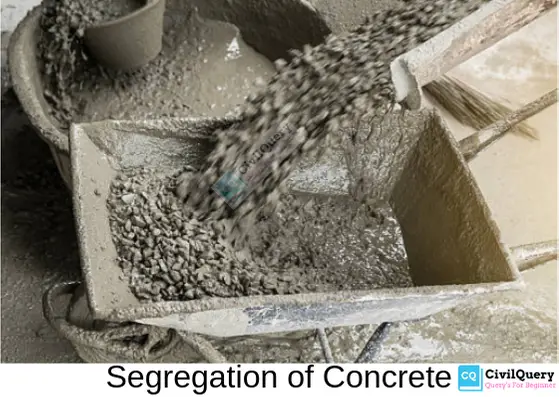Contents
What is Segregation of Concrete?
In concrete, the constituent material is cement, sand, aggregate, and water. Generally, a concrete aggregate is coated with cement and sand to form the uniform mass separation of these constituent materials of concrete from each other is defined as segregation of concrete.
Type of segregation
- Separation of course aggregate from the paste.
- Separation of course agreement paste from the concrete.
- Separation of water from the cement mix which is also known as bleeding.
The segregation includes undesirable properties in the hardened concrete. It can also cause honeycombing in concrete. Segregation also has ill effects on durability, compressive strength and all other characteristics of concrete. It also leads to the development of cavities in the concrete surface.
Causes of segregation
The root cause of segregation of concrete is difference in specific gravity and size of its constituent material. Specific gravity of water is 1. Specific gravity of cement is around 3.15 while that of aggregate is 2.6 to 2.7. Due to difference in specific gravity lighter particle have tendency to move upwards and heavier particle tend to move downwards. This results in segregation of concrete.
Other causes include high water cement ratio in concrete. Adding excess water while mixing concrete may lead to segregation. Incorrect vibration for too long on wet mix of concrete may lead to heavy material setting down and lighter cement sand paste to move upwards. Incorrectly proportioned mix and improper placing on site may also result in segregation.
Segregation can also occur when concreting is done from a height more than 1 metre. It may also occur due to vibrations during transport of concrete. In such cases proper remixing should be done but before the setting time is over.
Prevention of segregation
Segregation of concrete can be prevented by correctly proportioning the mix and using the recommended water-cement ratio so as to prevent using excess water. Care should be taken while handling, placing, transporting, compacting and also at finishing stages. Properly using air entraining agents, admixtures, pozzolanic materials can also prevent segregation.
As mentioned earlier, remixing the concrete for a short period of time may also prevent segregation. In a case where the depth of concrete is more than 1.5 meter, it should be placed through inclined chutes. The end of the chute should be as close to the point of concrete as possible. The angle of inclination should be kept so as to allow smooth travel of the concrete. Also, lubricate the path using a small quantity of water at regular intervals.
Bleeding in concrete

The Bleeding in concrete is a form of segregation. As the specific gravity of water is low, it tends to move upward due to the settlement of cement and aggregate. This represented as bleeding of concrete.
Bleeding of concrete is not completely harmful if the rate of bleeding is equal to the rate of evaporation of water. It actually enhances the workability of concrete which is good.
Causes of bleeding in Concrete
- High water-cement ratio leading to highly wet mix.
- Badly proportioned and insufficiently mixed concrete.
Effects of bleeding in Concrete
Due to bleeding, concrete loses its uniformity. The accumulation of water forms a void between the cement and other constituent materials hence reducing the strength. It also reduces the bond between reinforcement and concrete.
Prevent bleeding of Concrete
Controlling the water-cement ratio can prevent bleeding. Similarly proper proportioning and complete mixing can also reduce bleeding. Also, the use of air-entraining agents is recommended.



A lot of useful information here. Thanks sir for your effort!
Dear friends,
I’m using Siva plast plasticiser for water reduce chemical in concrete , I’m following all prevention for segregation, but still while flow from miller it’s segregates and in pumping it’s not .. what reason is there anything problem in mix design or chemical!?